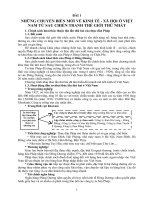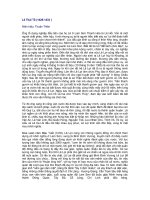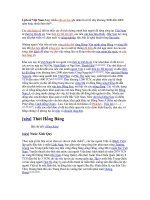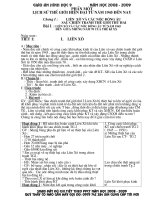100 years of fashion - Lịch sử 100 năm của thời trang
Bạn đang xem bản rút gọn của tài liệu. Xem và tải ngay bản đầy đủ của tài liệu tại đây (3.62 MB, 46 trang )
100 YEARS OF
FASHION
A very Brief History
1920’S
EVENTS 1920’S
Post WW1, Paris
Influence
Women’s Vote
Prohibition
Talking Movies
Increasing Prosperity
Modern Art, music,
literature
Birth of Sportswear
PUBLIC REACTIONS – 1920’S
Daring looks and
behavior
Freedom for the body
Short hair styles
Women begin to smoke
Dancing (Charleston)
FASHION TRENDS – 1920’S
Chemise Dresses
Short skirts
T-strap shoes
Cloche hats
Costume looks
Long strands of beads
DESIGNERS – 1920’S
Madeleine Vionnet
Jean Patou
Edward Molyneaux
Coco Channel
Norman Hartnell
Jeanne Lanvin
1930’S
EVENTS – 1930’S
Depression era
Unemployment, little $
Hollywood influence;
stars and designers
Rayon and acetate fabrics
Big bands, swing music
PUBLIC REACTIONS –
1930’S
Frugality, conservatism
“The little woman”
“Make do” attitude
FASHION TRENDS 1930’S
Soft looks, light fabrics
Long hems, bias cuts
Big hats, big brims
Fox fur-collared coats
Wraps
Platform shoes
Broad shouldered jackets
1930’S DESIGNERS
Madame Gres
Elsa Schiaparelli
Vera Maxwell
Mainbocher
Jean Dresses
1940’S
EVENTS – 1940’S
World War II:
government restrictions
Shortage of materials
Emergence of American
designers
Exit France as fashion
source
Crooners: Crosby, Sinatra
Radio, records
Dior – 1947 “New Look”
1940’S - PUBLIC
REACTIONS
Women take men’s jobs
Glamour, pinup girls
Strong nationalism
Common cause
philosophy
FASHION TRENDS 1940’S
Mannish suits, tailored ,
peplum jackets
Padded shoulders
Knee-length straight
skirts
Soft, shoulder-length hair
¾ length coats
Debut of the bikini
1940’S DESIGNERS
Claire McCardell
Norman Norell
Christian Dior
Cristobal Balenciaga
Bonnie Cashin
Adrian
Pauline Trigere
Nina Ricci
1950’S
EVENTS – 1950’S
Baby boom – population
increasing
Korean war
Move to suburbs
Income rising
More imports
Improved transportation,
communications (TV)
Birth of Rock ‘n’ roll
More synthetics, finishes
1950’S - PUBLIC
REACTIONS
Buy new homes,
appliances
Conformity
Improved quality of
family life
Increased leisure time
used for sports &
recreation
The station wagon
FASHION TRENDS 1950’S
Classics – shirtwaist dress
Sweater sets
Unisex looks
Sportswear
Ivy League look: buttondown shirts, skinny ties,
gray flannel suit
Car coats
Capri pants
1950’S DESIGNERS
Hubert de Givenchy
Mary Quant
Yves Saint Laurent
James Galanos
Donald Brooks
Gucci
Missoni
1960’S
EVENTS – 1960’S
Rise of shopping centers,
boutiques
New technology – stretch
fabrics
Designer names
Civil rights movement
Woodstock
Vietnam war; antiwar
movement
London influence: The
Beatles, Twiggy, Mod
1960’S - PUBLIC
REACTIONS
New sexual freedom
Experimental in fashion
Antiestablishment
attitudes
Generation gap
Divorce, singles
Drug experimentation
Identity seeking, new
values
FASHION TRENDS 1960’S
Jeans
Miniskirts
Knits, polyesther
Ethnic clothing & crafts
Wild use of color patterns
Long hair, wigs
Vinyl, synthetic fabrics
Turtlenecks, wide ties,
Nehru jackets, golf
coordinates









